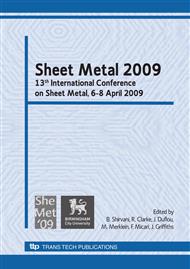p.355
p.365
p.373
p.381
p.391
p.401
p.413
p.421
p.429
Experimental Tests to Study Feasibility and Formability in Incremental Forming Process
Abstract:
This paper deals with Incremental Sheet Forming (ISF), a sheet metal forming process, that knew a wide development in the last years. It consists of a simple hemispherical tool that, moving along a defined path by means of either a CNC machine or a robot or a self designed device, locally deforms a metal sheet. A lot of experimental and simulative researches have been conducted in this field with different aims: to study the sheet formability and part feasibility as a function of the process parameters; to define models able to forecast the final sheet thickness as a function of the drawing angle and tool path strategy; to understand how the sheet deforms and how formability limits can be defined. Nowadays, a lot of these topics are still open. In this paper, the results obtained from an experimental campaign performed to study sheet formability and final part feasibility are reported. The ISF tests were conducted deforming FeP04 deep drawing steel sheet 0.8 mm thick and analyzing the influence of the tool path strategy and of the adopted ISF technique (Single Point Incremental Forming Vs. Two Points Incremental Forming). The part feasibility and formability were evaluated considering final sheet thickness, geometrical errors of the final part, maximum wall angle and depth at which the sheet breaks. Moreover, process forces measurements were carried out by means of a specific device developed by the Authors, allowing to obtain important information about the load acting on the deforming device and necessary for deforming sheet.
Info:
Periodical:
Pages:
391-400
Citation:
Online since:
March 2009
Keywords:
Price:
Сopyright:
© 2009 Trans Tech Publications Ltd. All Rights Reserved
Share:
Citation:


